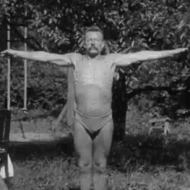Whereas it is not advisable to perform heel-raising and full knee-bending during the respiratory pauses, even for the strongest individuals, it is in many instances an excellent plan to carry out these powerful leg movements – as a special exercise that can easily be performed just before or after Ex. No. 8. It is particularly recommended to motorists and others, who are too lazy, or who don’t take time to walk. I will here describe a slow and quick exercise, both only for advanced.
- Raise yourself slowly up on the toes, with heels together, at the same time lifting the arms sideways and pressing the hands backwards at the wrists, with fingers well stretched, all the while inhaling (see Fig. 3). Lower the body slowly while bending the legs, knees well outwards, until the seat touches the heels. The arms should simultaneously be lowered to the inside of the knees, with fingers clenched and fists turned inwards from the wrist, during expiration (see Fig 4). Then the legs and fingers are once more straightened while the arms are lifted and you must take up the previously described “stretched” position, and down during the ten full respirations; breathing in always during the upward movement, and out during the downward movement. During the last expiration, just lower the heals and arms very slowly.
- You should perform similar full knee-bendings, but now as quickly as possible; after, practise two bendings and stretchings during inhalation and three double movements during exhalation. The heels remain raised and well pressed together all through, as in the first exercise. There are no finger and wrist movements, nor arm raising and lowering. The arms are held out obliquely in front or inclined to sides to balance the body. Perform up to twenty knee-bendings during four full respirations, but don’t forget to stretch the legs completely in each upward movement.

